
Am Fam Physician. 2018;97(3):180-186
Patient information: A handout on tremors, written by the authors of this article, is available.
Author disclosure: No relevant financial affiliations.
Tremor is an involuntary, rhythmic, oscillatory movement of a body part. It is the most common movement disorder encountered in primary care. The diagnosis of tremor is based on clinical information obtained from the history and physical examination. The most common tremors in patients presenting to primary care physicians are enhanced physiologic tremor, essential tremor, and parkinsonian tremor. All persons have low-amplitude, high-frequency physiologic tremors at rest and during action that are not reported as symptomatic, but can be enhanced by anxiety, medication use, caffeine intake, or fatigue. Features consistent with psychogenic tremor are abrupt onset, spontaneous remission, changing tremor characteristics, and extinction with distraction. Other types of tremor include cerebellar, dystonic, and drug- or metabolic-induced. The first step in evaluating a patient with tremor is to categorize the tremor based on its activation condition, topographic distribution, and frequency. Resting tremors occur in a body part that is relaxed and completely supported against gravity. Action tremors occur with voluntary contraction of a muscle and can be further subdivided into postural, isometric, and kinetic tremors. The most common pathologic tremor is essential tremor, which affects 0.4% to 6% of the population. In one-half of cases, it is transmitted in an autosomal-dominant fashion. More than 70% of patients with Parkinson disease have tremor as the presenting feature. This tremor is typically unilateral, occurs at rest, and becomes less prominent with voluntary movement. If there is diagnostic uncertainty, single-photon emission computed tomography can be used to visualize the integrity of the dopaminergic pathways in the brain, and transcranial ultrasonography may be useful to diagnose Parkinson disease.
Tremor is an involuntary, rhythmic, oscillatory movement of a body part and is the most common movement disorder encountered in primary care practices.1–3 Aside from careful clinical examination and imaging when needed, there is no standard test to distinguish between common types of tremor, which can make the evaluation challenging. However, establishing the underlying cause is important because prognosis and specific treatment plans vary considerably. The most common tremors in patients presenting to primary care physicians are enhanced physiologic tremor, essential tremor, and parkinsonian tremor.1,3–6 All tremors are more common in older age.7
| Clinical recommendation | Evidence rating | References |
|---|---|---|
| A resting tremor is usually caused by parkinsonism. | C | 1, 11 |
| Patients with new-onset tremor should have a comprehensive review of medications (prescribed and over-the-counter), with specific attention to medications started before the onset of tremor. | C | 8, 12, 13 |
| The diagnosis of tremor is based on clinical information obtained from the history and physical examination. | C | 2, 17 |
| Tremor in children is potentially serious; patients should be promptly referred to a neurologist. | C | 26, 27 |
| In select cases when there is significant diagnostic uncertainty, single-photon emission computed tomography using ioflupane can be useful for distinguishing Parkinson disease from other tremor types. | C | 29, 30, 32 |
Classification
Tremors are classified as resting or action (Table 1).1,8,9 A resting tremor occurs in a body part that is relaxed and completely supported against gravity (e.g., when resting on the arm of a chair). It is typically enhanced by mental stress (e.g., counting backward) or movement of another body part (e.g., walking), and diminished by voluntary movement.3,10,11 Most tremors are action tremors, which occur with voluntary muscle contraction. Action tremors are subdivided into postural, isometric, and kinetic tremors.8,10 A postural tremor is present while maintaining a position against gravity (e.g., arm elevation). An isometric tremor occurs with muscle contraction against a rigid stationary object (e.g., when making a fist). A kinetic tremor is associated with voluntary movement and includes intention tremor, which is produced with target-directed movement.2
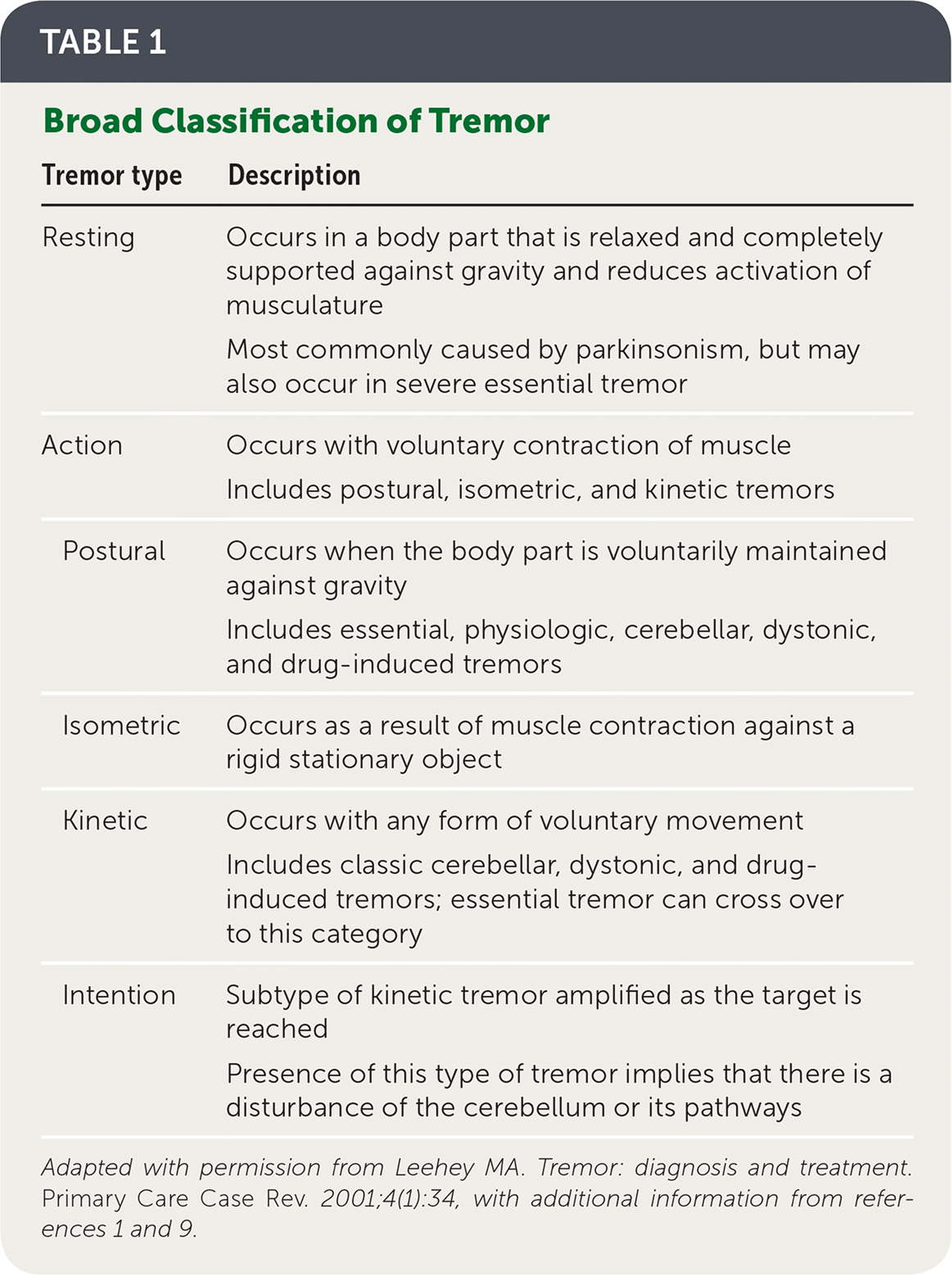
| Tremor type | Description | |
|---|---|---|
| Resting | Occurs in a body part that is relaxed and completely supported against gravity and reduces activation of musculature | |
| Most commonly caused by parkinsonism, but may also occur in severe essential tremor | ||
| Action | Occurs with voluntary contraction of muscle | |
| Includes postural, isometric, and kinetic tremors | ||
| Postural | Occurs when the body part is voluntarily maintained against gravity | |
| Includes essential, physiologic, cerebellar, dystonic, and drug-induced tremors | ||
| Isometric | Occurs as a result of muscle contraction against a rigid stationary object | |
| Kinetic | Occurs with any form of voluntary movement | |
| Includes classic cerebellar, dystonic, and drug-induced tremors; essential tremor can cross over to this category | ||
| Intention | Subtype of kinetic tremor amplified as the target is reached | |
| Presence of this type of tremor implies that there is a disturbance of the cerebellum or its pathways | ||
Enhanced Physiologic Tremor
All persons have an asymptomatic physiologic tremor. It is a low-amplitude, high-frequency tremor at rest and during action. This tremor can be enhanced by anxiety, stress, certain medications, and metabolic conditions. Patients with a tremor that comes and goes with anxiety, medication use, caffeine intake, or fatigue do not need further testing.1,8
Essential Tremor
The most common pathologic tremor is essential tremor, which is an action tremor. Essential tremor has been described as postural, kinetic, and even as a sporadic resting tremor.3,12 One study found that 95% of patients with essential tremor had primarily kinetic, rather than postural, characteristics.12 Essential tremor is most obvious in the wrists and hands when patients hold their arms in front of them; however, it can also affect the head, lower extremities, and voice.13 It is generally bilateral, is present with different tasks, and interferes with activities of daily living.1,5
Essential tremor affects 0.4% to 6% of the population.4 In about one-half of cases, it is transmitted in an autosomal-dominant fashion.8 Although essential tremor can manifest by early adulthood, most patients do not present for treatment until 60 to 69 years of age because it tends to progress slowly. Sometimes called benign essential tremor, essential tremor often causes social embarrassment, and up to 25% of those affected retire early or modify their career path.4,8,9 Importantly, 30% to 50% of those initially diagnosed with essential tremor eventually receive an additional tremor diagnosis or a different diagnosis entirely after further evaluation.12
The diagnosis of essential tremor is clinical, based on classic symptoms and tremor features.2 Persons with essential tremor typically have no other neurologic findings; therefore, it is sometimes considered a diagnosis of exclusion.13 A video of this tremor is available.
Parkinsonism
Parkinsonism is a clinical syndrome characterized by tremor, bradykinesia, rigidity, and postural instability. Many patients also have micrographia, shuffling gait, and masked facies.11,14–16 Various medications cause parkinsonism by blocking or depleting dopamine levels (e.g., methyldopa, metoclopramide [Reglan], haloperidol).10,11 The most common form is idiopathic Parkinson disease, a chronic neurodegenerative disorder with a prevalence of 1%.17
Approximately 70% of patients with Parkinson disease have resting tremor as the presenting feature.1,11 The classic parkinsonian tremor begins as a low-frequency, pill-rolling motion of the fingers, progressing to forearm pronation/supination and elbow flexion/extension. It is typically unilateral, occurs at rest, and fades with voluntary movement. It can reemerge after latency with maintenance of posture, which can create diagnostic confusion. Tremor can involve the leg and jaw as well.3,9 A video example of this tremor is available.
Drug- and Metabolic-Induced Tremors
Dozens of medications can cause or exacerbate any type of tremor (Table 2).18 Patients with new-onset tremor should have a comprehensive medication review with specific attention to any medications started before the onset of tremor.8 Medications that stimulate the sympathetic nervous system (e.g., amphetamines, terbutaline, pseudoephedrine) and psychoactive medications (e.g., tricyclic antidepressants, haloperidol, fluoxetine [Prozac]) are most likely to cause a postural tremor.1,8,12,13 When the medication review reveals a likely culprit, a trial discontinuation should be attempted if clinically possible.
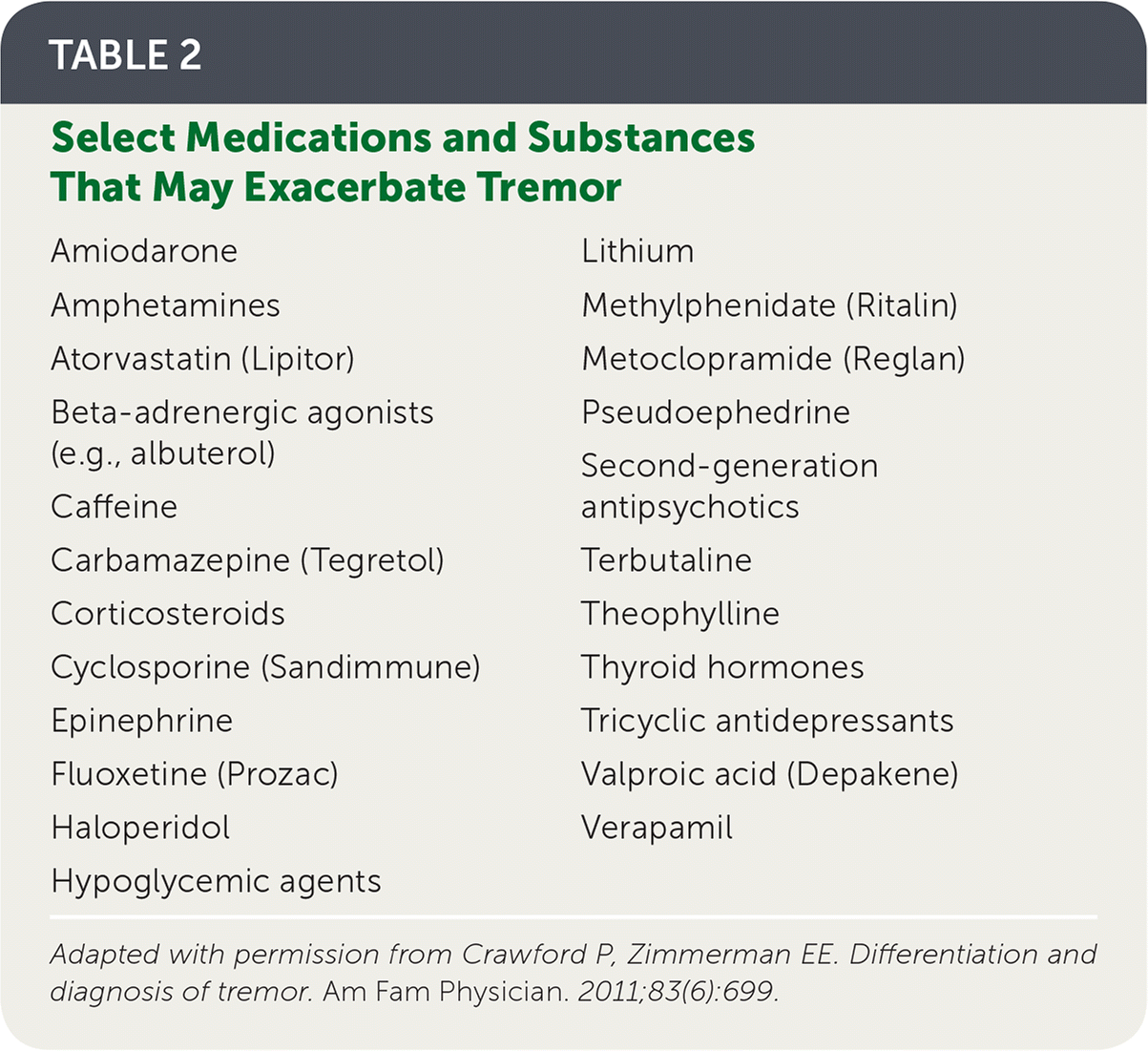
| Amiodarone |
| Amphetamines |
| Atorvastatin (Lipitor) |
| Beta-adrenergic agonists (e.g., albuterol) |
| Caffeine |
| Carbamazepine (Tegretol) |
| Corticosteroids |
| Cyclosporine (Sandimmune) |
| Epinephrine |
| Fluoxetine (Prozac) |
| Haloperidol |
| Hypoglycemic agents |
| Lithium |
| Methylphenidate (Ritalin) |
| Metoclopramide (Reglan) |
| Pseudoephedrine |
| Second-generation antipsychotics |
| Terbutaline |
| Theophylline |
| Thyroid hormones |
| Tricyclic antidepressants |
| Valproic acid (Depakene) |
| Verapamil |
Cerebellar Tremor
The classic cerebellar tremor presents as a disabling, low-frequency, slow-intention, or postural tremor, and is typically caused by multiple sclerosis with cerebellar plaques, stroke, or brainstem tumors. Most patients have other neurologic signs of cerebellar dysfunction, including dysmetria (overshoot on finger-to-nose testing), dyssynergia (abnormal heel-to-shin testing), and hypotonia.8,19 A video example of this tremor is available.
PSYCHOGENIC TREMOR
Differentiating between organic and psychogenic tremor can be difficult. Features consistent with psychogenic tremor are abrupt onset, spontaneous remission, changing tremor characteristics (including location and frequency), and extinction with distraction8,20 (Table 318). Often, there is a stressful life event that precedes the tremor.3
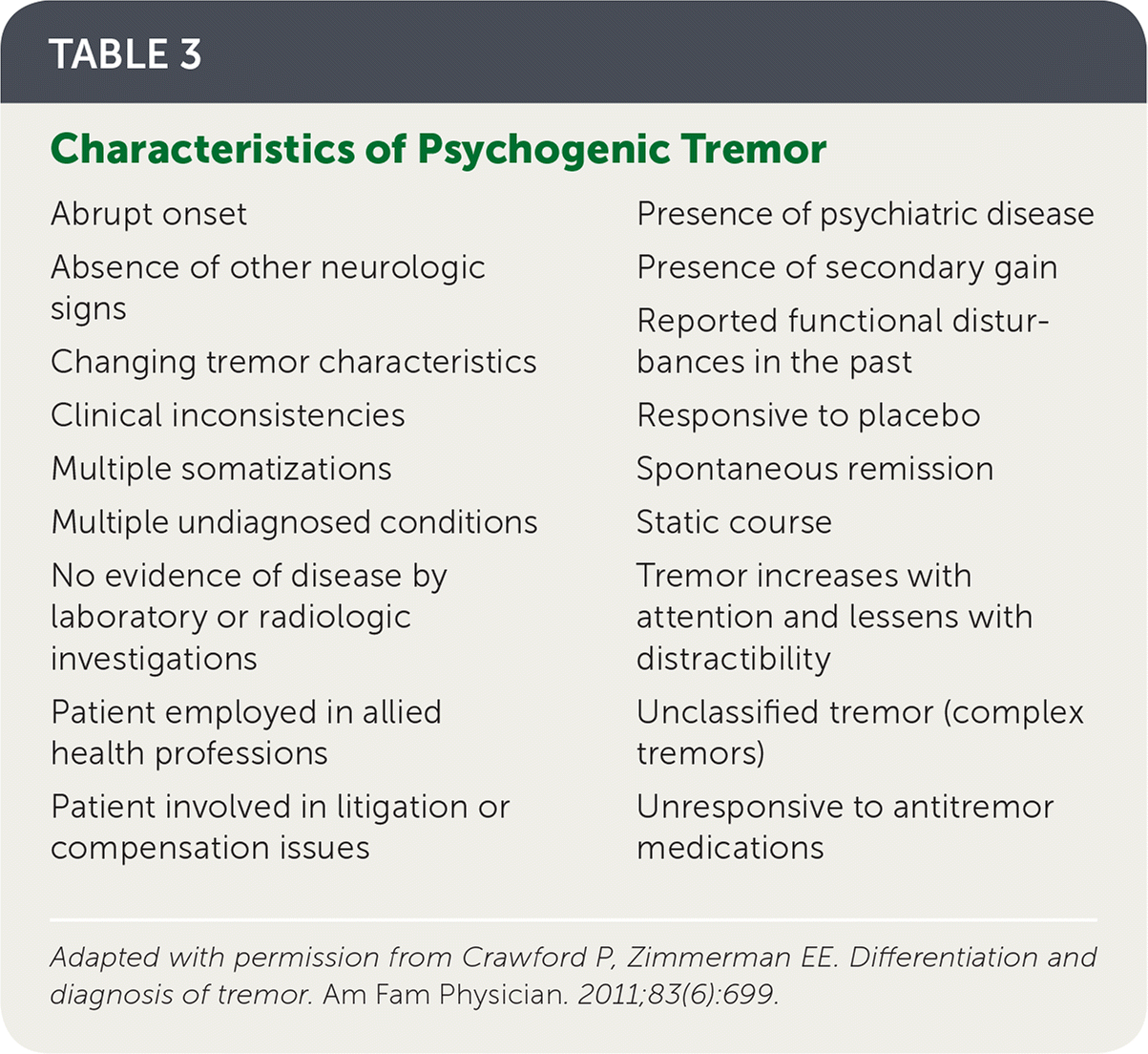
| Abrupt onset |
| Absence of other neurologic signs |
| Changing tremor characteristics |
| Clinical inconsistencies |
| Multiple somatizations |
| Multiple undiagnosed conditions |
| No evidence of disease by laboratory or radiologic investigations |
| Patient employed in allied health professions |
| Patient involved in litigation or compensation issues |
| Presence of psychiatric disease |
| Presence of secondary gain |
| Reported functional disturbances in the past |
| Responsive to placebo |
| Spontaneous remission |
| Static course |
| Tremor increases with attention and lessens with distractibility |
| Unclassified tremor (complex tremors) |
| Unresponsive to antitremor medications |
DYSTONIC TREMOR
Dystonic tremor is rare, appearing in 0.03% of the population. It typically occurs in patients younger than 50 years. The tremor is usually irregular and jerky, and certain hand or arm positions extinguish the tremor. Other signs of dystonia (e.g., abnormal flexion of the wrists) are always present.8,21
WILSON DISEASE
Wilson disease is a rare, autosomal-recessive disorder that manifests in persons five to 40 years of age, sometimes with a wing-beating tremor. Measurement of serum ceruloplasmin level and 24-hour urinary copper excretion should be considered in young patients presenting with tremor to exclude this potentially life-threatening disease.16,22 A video example of this tremor is available.
Diagnostic Approach
The diagnosis of tremor is generally based on clinical information obtained from the history and physical examination.17 Although there is overlap and variability among tremor syndromes, the intrinsic features of the tremor usually provide key diagnostic clues (Figure 118; Table 418). The first step is to categorize the tremor based on its activation condition, topographic distribution, and frequency. The activation condition should be described as resting, kinetic (or intention), postural, or isometric. The examiner can have the patient sit with his or her hands in the lap to check for rest tremor. A sequential test for postural and kinetic tremors can involve the patient stretching his or her arms and hands out, followed by a simple finger-to-nose test.2,3 A resting tremor is virtually pathognomonic for parkinsonism, whereas an intention tremor often indicates a cerebellar lesion.11 Frequency is generally classified as low (less than 4 Hz), medium (4 to 7 Hz), or high (more than 7 Hz). The topographic distribution of the tremor (e.g., limbs, head, voice) can also provide useful information. For example, a high-frequency tremor involving the head is more likely to be essential tremor than parkinsonian tremor.2,3
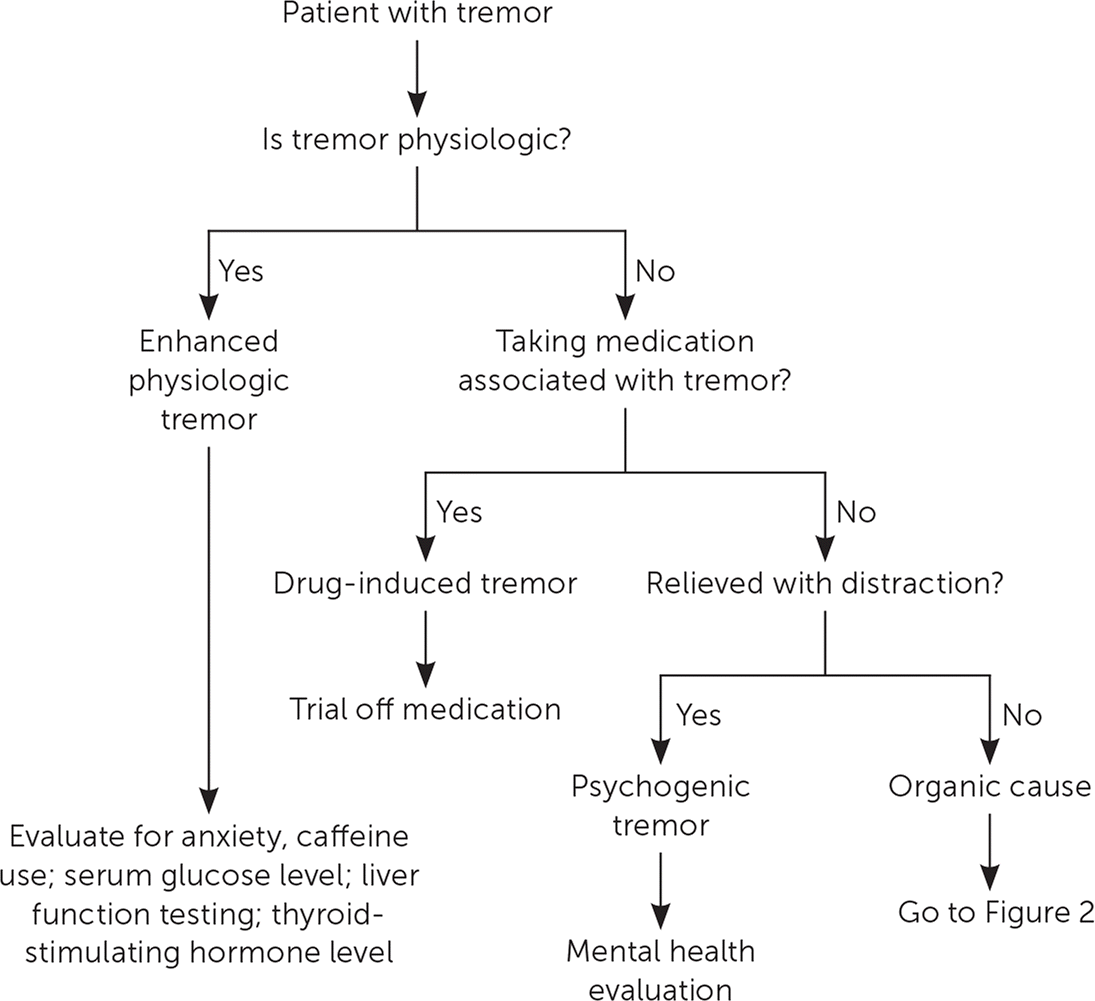
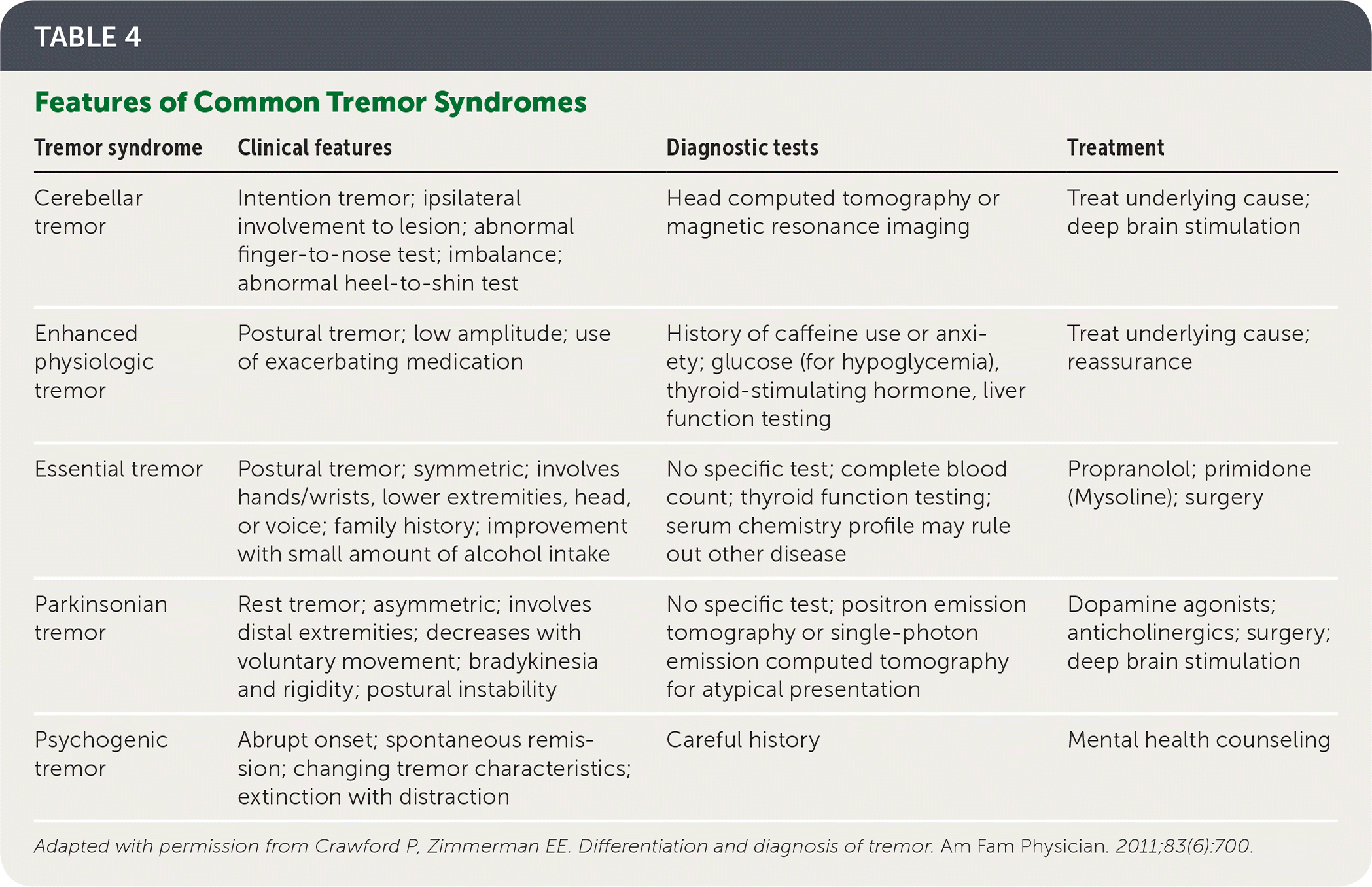
| Tremor syndrome | Clinical features | Diagnostic tests | Treatment |
|---|---|---|---|
| Cerebellar tremor | Intention tremor; ipsilateral involvement to lesion; abnormal finger-to-nose test; imbalance; abnormal heel-to-shin test | Head computed tomography or magnetic resonance imaging | Treat underlying cause; deep brain stimulation |
| Enhanced physiologic tremor | Postural tremor; low amplitude; use of exacerbating medication | History of caffeine use or anxiety; glucose (for hypoglycemia), thyroid-stimulating hormone, liver function testing | Treat underlying cause; reassurance |
| Essential tremor | Postural tremor; symmetric; involves hands/wrists, lower extremities, head, or voice; family history; improvement with small amount of alcohol intake | No specific test; complete blood count; thyroid function testing; serum chemistry profile may rule out other disease | Propranolol; primidone (Mysoline); surgery |
| Parkinsonian tremor | Rest tremor; asymmetric; involves distal extremities; decreases with voluntary movement; bradykinesia and rigidity; postural instability | No specific test; positron emission tomography or single-photon emission computed tomography for atypical presentation | Dopamine agonists; anticholinergics; surgery; deep brain stimulation |
| Psychogenic tremor | Abrupt onset; spontaneous remission; changing tremor characteristics; extinction with distraction | Careful history | Mental health counseling |
Several historical clues can play important roles in differentiating tremor (Figure 218). Tremor in older patients and gradual onset are more likely to be Parkinson disease or essential tremor. Sudden onset of tremor is more likely to be caused by medication use, toxins, a psychogenic cause, or, in rare cases, a brain tumor. A list of clinical features that help differentiate between essential tremor and Parkinson disease is available.
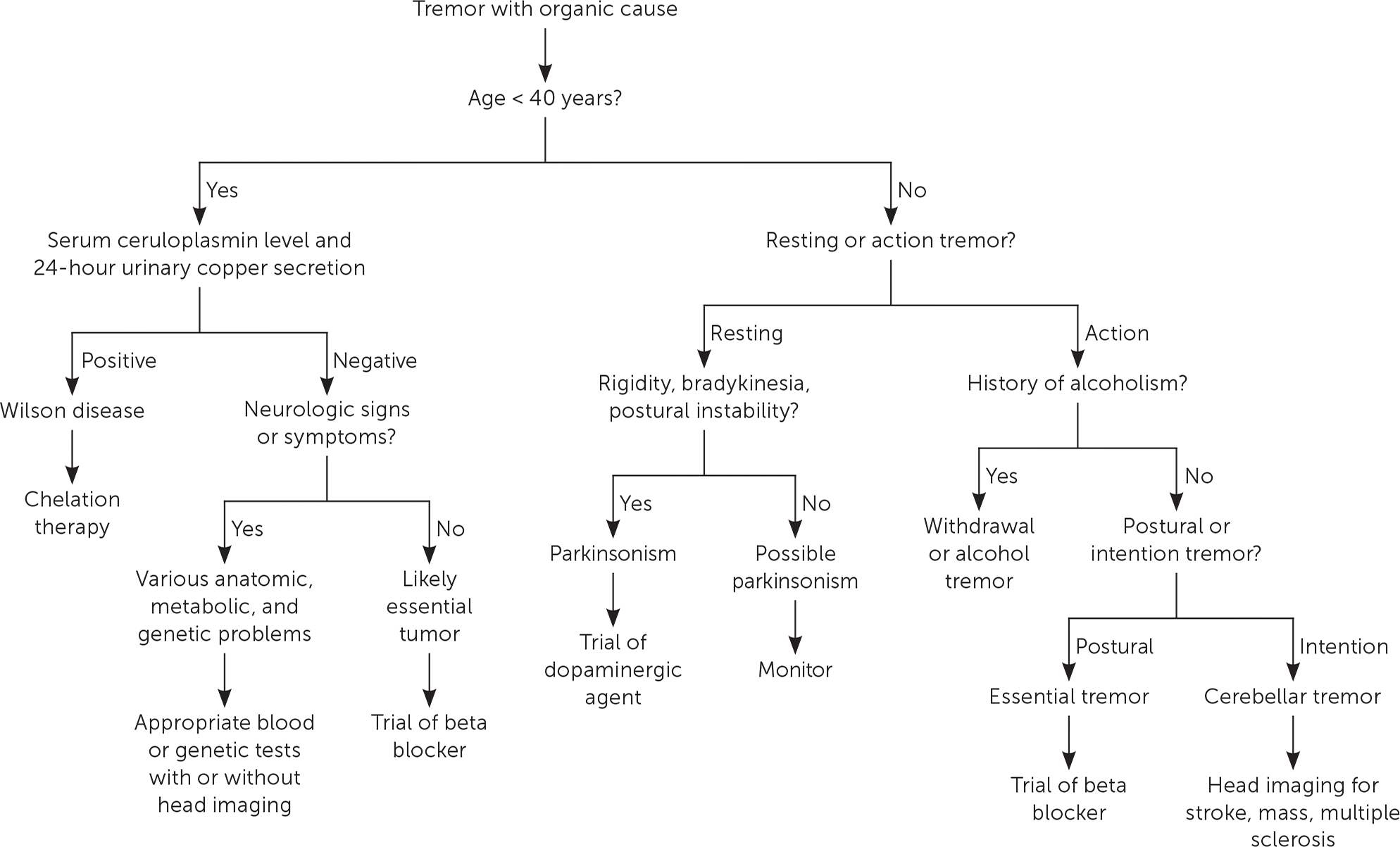
Caffeine intake and fatigue are often exacerbating factors in essential tremor with few alleviating factors. Associated conditions and diseases should be identified. For example, fatigued muscles from sleep disorders amplify physiologic tremor, and polyneuropathy from lack of innervations causes small involuntary movements that may be interpreted as tremor. A family history of neurologic disease or tremor suggests a genetic component, which is common in essential tremor. A medication history should be obtained to rule out drug-induced tremor. Patients should be screened for drugs of abuse as well as alcohol overuse and withdrawal because these can cause tremor. Conversely, small amounts of alcohol (30 to 60 g) can temporarily relieve essential tremor and can be a historical clue to the diagnosis.2,3
The assessment of tremor also includes examination for signs associated with tremor syndromes. Bradykinesia and postural abnormalities, which are late findings, strongly suggest parkinsonism.22 Difficulty rising from a seated position, micrographia, reduced arm swing while walking, and masked facies are also features of bradykinesia.23 Postural abnormalities can be demonstrated by a positive pull test, where the patient stands in a neutral position and the examiner causes him or her to become unsteady by pulling on the upper arms from behind. This can help isolate cerebellar tremor and prompt evaluation for multiple sclerosis or stroke.24 Similarly, coactivation sign is resistance during passive movement of a tremulous limb, but with disappearance of the tremor, which indicates psychogenic tremor. If essential tremor and parkinsonism are both possible diagnoses, the patient should be asked to draw a clockwise spiral. A large, shaky spiral points to essential tremor; however, a small, quivery spiral means that parkinsonism is likely.25 The examiner should also look for dystonia (i.e., sustained muscle contraction), cerebellar signs (e.g., ataxia, incoordination), pyramidal signs, neuropathic signs, and signs of systemic disease (e.g., thyrotoxicosis). A shuffling gait is consistent with parkinsonism.2,8,25
Stanford University has a brief tutorial on the approach to tremor available.
TREMOR IN CHILDREN
The diagnosis of tremor in children is challenging because of myriad potential causes, such as Wilson disease, fragile X syndrome, nutritional deficiencies (e.g., vitamin B12), heavy metal poisoning, and essential tremor. Almost one-half of children with traumatic brain injury experience tremor for up to 18 months.26 All childhood tremors are potentially serious and should prompt an in-depth investigation to clarify the cause; patients should be promptly referred to a neurologist.27
Imaging
Although the diagnosis of tremor remains primarily clinical, certain imaging modalities can help differentiate some causes of tremor. Noncontrast magnetic resonance imaging and computed tomography can rule out secondary causes of tremor (e.g., multiple sclerosis, mass lesion, stroke) when the history and physical examination are suggestive of a structural cause, or in parkinsonism with atypical features or that is refractory to levodopa.28
If there is diagnostic uncertainty, single-photon emission computed tomography (SPECT) using ioflupane (123I-FP-CIT SPECT or DaTSCAN), in addition to subspecialty consultation, can be useful for distinguishing Parkinson disease from essential tremor, and to a lesser extent from drug-induced tremor, dystonic tremor, psychogenic tremor, or unilateral postural tremor.29,30 When assessing for dopamine transporter dysfunction, 123I-FP-CIT SPECT was 78% sensitive and 97% specific, with a positive likelihood ratio of 26 and a negative likelihood ratio of 0.23 in one case series of 99 patients with suspected Parkinson disease.31 A positive test can therefore rule in a diagnosis of Parkinson disease within three years; however, it is not superior to clinical assessment in the diagnosis of Parkinson disease,29 and its specific clinical use remains unclear.32
Transcranial ultrasonography can also predict Parkinson disease by revealing hyperechogenicity of the substantia nigra. A European study of 49 patients in a neurology clinic demonstrated that ultrasonography compared favorably vs. 123I-FP-CIT SPECT for sensitivity (90% vs. 97%), specificity (60% vs. 70%), positive predictive value (77% vs. 82%), and negative predictive value (80% vs. 93%) for the diagnosis of Parkinson disease. Operator inexperience and limited fusion imaging technology, as well as conflicting results from several clinical studies, limit the use of transcranial ultrasonography.33
This article updates previous articles on this topic by Crawford and Zimmerman18 ; Smaga34 ; and Charles, et al.35
Data Sources: A PubMed search was completed in Clinical Queries using the key terms tremor, movement disorders, ultrasound, and SPECT. The search included meta-analyses, randomized controlled trials, clinical trials, and reviews. Also searched were the Agency for Healthcare Research and Quality evidence reports, Bandolier, Clinical Evidence, FPIN's Clinical Inquiry database, the Cochrane database, the Institute for Clinical Systems Improvement, the National Guideline Clearinghouse database, Essential Evidence Plus, EBM Online, and UpToDate. Reference lists of recent review articles were also searched for articles not previously discovered. Search dates: January 10 and September 10, 2017.
The opinions expressed in this article do not represent the official opinions of the U.S. Air Force or the Department of Defense.
